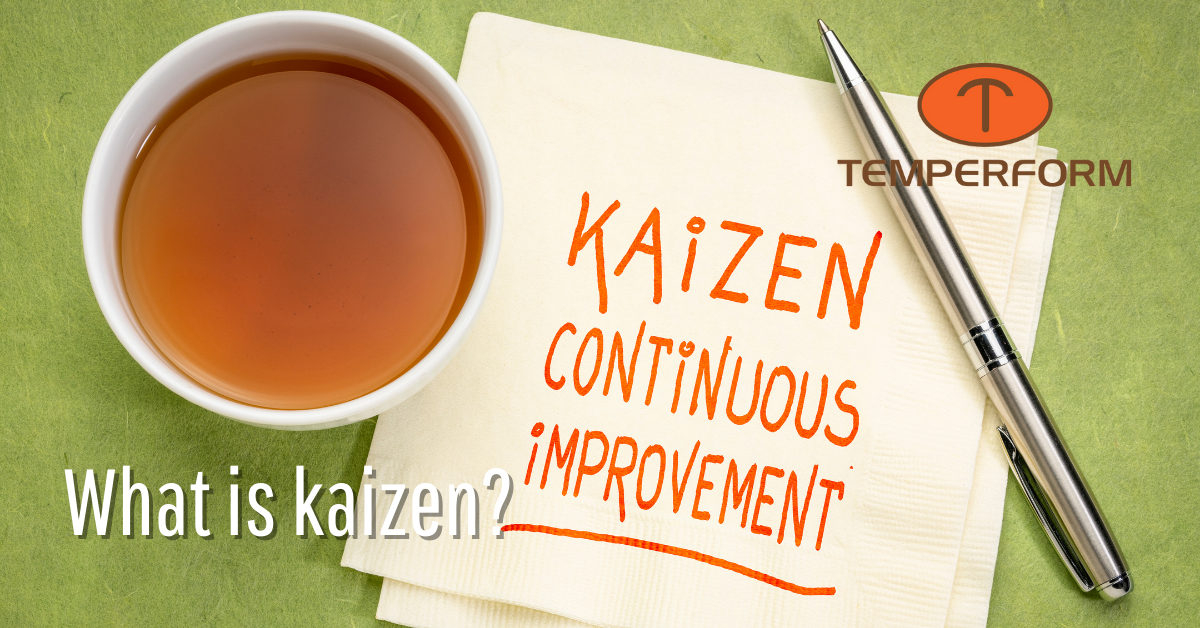
Kaizen is a Japanese expression meaning “change for better” or continuous improvement – whatever you are doing, you can do it better. At Temperform, we strive for continuous improvement every day.
Breaking apart and putting together
The first part of the word, kai, means “to break apart,” and zen means “to put back together better.” This is exactly what happens during a kaizen event—using cross-functional teams, and lean thinking ensures success and sustainable change. During a one- to five-day kaizen event, you can make changes in a week or less that would typically take months.
The team
A cross-functional team is composed of 5 to 10 people, depending on the scope of the event. This team should include:
- Target area employees from all shifts
- The customer of and supplier to the process
- Maintenance (if applicable)
- Anyone with “outside eyes” who can provide a valuable perspective on the target area
- An experienced facilitator with a deep understanding of lean tools and philosophies
We want our improvement activities to involve everyone in the organization – management and hourly workers. We track employee hours invested in kaizen events and reward their participation. We always ensure sign-up sheets for every kaizen event are prominently displayed to encourage participation.
The process
The kaizen event is the improvement process itself. Within it, you can use any popular lean tools, such as a Spaghetti diagram kaizen, a 6S kaizen that incorporates many of the lean tools, a Value Stream Map kaizen, a Total Productive Maintenance (TPM) kaizen, a Single Minute Exchange of Die (SMED) kaizen, and others.
The kaizen process begins with analyzing the current state of the target area process. The next step is to interview all employees that affect, or have been affected by, the existing target area process. These interviews help you identify problems, inefficiencies, and other areas for potential improvement. The kaizen process continues with brainstorming issues and challenges based on your analysis and interviews.
The next step is to categorize all the identified issues and challenges, split them up into teams, and brainstorm and implement improvement ideas. Once the improvements are implemented, the team will verify that the future state of the target area process has been achieved. Following this step, the team will test and verify the proposed future state.
The final step is to standardize and sustain the new target area process. The team accomplishes this by writing standard operating procedures and work instructions. They also develop forms, audits, end-of-shift requirements, and other work aids to help them maintain their new process. Finally, all affected employees are trained in the new process.
As teams travel through the kaizen event, we constantly remind ourselves of some of its key concepts:
- The team will always focus on issues and not make it personal – it’s about the process, not the people!
- The activity should require very little expense – do what you need with what you have!
- Results are incremental, but when added together, they bring about dramatic improvement.
- The kaizen approach is low risk – technically and financially.
- Before we brainstorm improvements, it is our responsibility to get input from all target area employees and any affected by the target area during the event.
- Once the improvements are implemented, it is the team’s responsibility to train all employees on the new process.
Another vital element to a kaizen event is ensuring employees are focusing on a specific scope or challenge. To help ensure this, we use a kaizen playbook, which includes goals and expectations, a team roster, and an agenda that identifies all of the team’s tools during the kaizen event. The playbook is developed four to six weeks before the event by the facilitator and the process owner.
The outcome
The incredible thing about the kaizen process is that you can use it for administrative and industrial purposes. At Temperform, we have adopted kaizen as our new way of life. It has become a key part of our company’s culture and continues to lead us on our journey toward continuous improvement. There is no limit to what we can achieve through the teamwork, revision, and critical thinking that kaizen inspires.